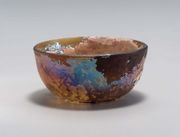Devitrified glass
Jump to navigation
Jump to search
Description
Devitrification occurs when the normally amorphous form of glass may slowly or rapidly becomes crystalline resulting in lost transparency and cohesive structure. Rapid devitrification may occur when molten glass is cooled too slowly thus allowing components to separate and crystallize. Slow devitrification may occur in moist soils or similar environments where alkaline components leach out, thus allowing the remaining silica-rich material to crystallize. Devitrified glass or ceramic glazes may appear to have a whitish haze or an iridescent sheen.
Synonyms and Related Terms
sugar glass; gedevitrificeerd glas (Ned.); vidro desvitrificado (Port.)
Resources and Citations
- Richard S. Lewis, Hawley's Condensed Chemical Dictionary, Van Nostrand Reinhold, New York, 10th ed., 1993
- ASTM, Standard Terminology Relating to Thermophysical Properties, Annual Book of ASTM Standards, Section 6, Paints, Related Coatings and Aromatics, ASTM, E1142, 695-696, Jul-94
- Walter C. McCrone, John Gustave Delly, The Particle Atlas, W. McCrone Associates, Chicago, IV, 1972
- Jack Odgen, Jewellery of the Ancient World, Rizzoli International Publications Inc., New York City, 1982
- Dictionary of Building Preservation, Ward Bucher, ed., John Wiley & Sons, Inc., New York City, 1996
